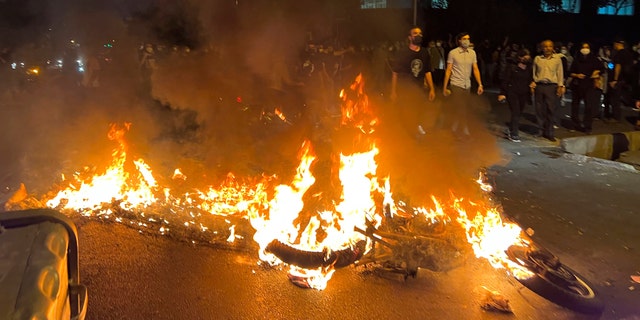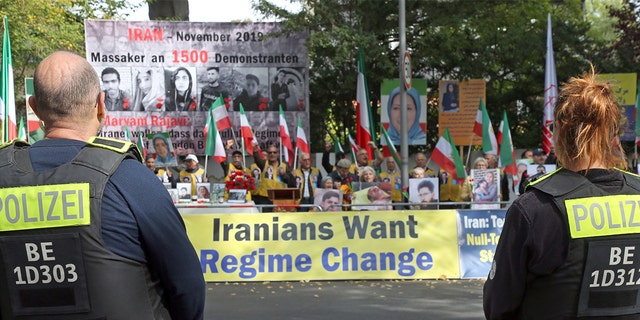Iran attack kills 19, including 4 elite Revolutionary Guard members
An attack by armed separatists on a police station in a southeastern city killed 19 people, including four members of Iran’s elite Islamic Revolutionary Guard, Iran’s state-run IRNA news agency reported Saturday.
The assailants in Friday’s attack hid among worshippers near a mosque in the city of Zahedan and attacked the nearby police station, according to the report.
IRNA quoted Hossein Modaresi, the provincial governor, as saying 19 people were killed. The outlet said 32 Guard members, including volunteer Basiji forces, were also wounded in the clashes.
It was not immediately clear if the attack was related to nationwide antigovernment protests gripping Iran after the death in police custody of a young Iranian woman.
IRANIAN AUTHORITIES ARREST CELEBRITIES, ARTISTS, FOREIGN NATIONALS, DURING PROTEST CRACKDOWN: REPORT
Sistan and Baluchestan province borders Afghanistan and Pakistan and has seen previous attacks on security forces by ethnic Baluchi separatists, although Saturday’s Tasnim report did not identify a separatist group allegedly involved in the attack.
IRNA on Saturday identified the dead as Hamidreza Hashemi, a Revolutionary Guard colonel; Mohammad Amin Azarshokr, a Guard member; Mohamad Amin Arefi, a Basiji, or volunteer force with the IRG; and Saeed Borhan Rigi, also a Basiji.
Tasnim and other state-linked Iranian news outlets reported Friday that the head of the Guard’s intelligence department, Seyyed Ali Mousavi, was shot during the attack and later died.
It is not unusual for IRG members to be present at police bases around the country.

IRAN PROTESTERS INSIST ISLAMIC REGIME ‘DOES NOT REPRESENT’ THE PEOPLE IN EXCLUSIVE INTERVIEW
Thousands of Iranians have taken to the streets over the last two weeks to protest the death of Mahsa Amini, a 22-year-old woman who had been detained by the morality police in the capital of Tehran for allegedly wearing her mandatory Islamic headscarf too loosely.
The protesters have vented their anger over the treatment of women and wider repression in the Islamic Republic. The nationwide demonstrations rapidly escalated into calls for the overthrow of the clerical establishment that has ruled Iran since its 1979 Islamic revolution.
The protests have drawn supporters from various ethnic groups, including Kurdish opposition movements in the northwest that operate along the border with neighboring Iraq. Amini was an Iranian Kurd and the protests first erupted in Kurdish areas.
Iranian state TV has reported that at least 41 protesters and police have been killed since the demonstrations began Sept. 17. An Associated Press count of official statements by authorities tallied at least 14 dead, with more than 1,500 demonstrators arrested.
IRAQ SUMMONS IRANIAN AMBASSADOR FOLLOWING DEADLY BOMBING CAMPAIGN
Also on Friday, Iran said it had arrested nine foreigners linked to the protests, which authorities have blamed on hostile foreign entities, without providing evidence.
It has been difficult to gauge the extent of the protests, particularly outside of Tehran. Iranian media have only sporadically covered the demonstrations.
Witnesses said scattered protests involving dozens of demonstrators took place Saturday around a university in downtown Tehran. Riot police dispersed the protesters, who chanted “death to dictator.” Some witnesses said police fired teargas.

Iranian opposition leader Mir Hossein Mousavi, meanwhile, reminded Iran’s armed forces of their duty to people’s lives and rights, the foreign-based opposition Telegram channel Kaleme reported.
Mousavi’s Green Movement challenged Iran’s disputed 2009 presidential election in unrest at a level unseen since its 1979 Islamic Revolution before being crushed by authorities.
“Obviously your capability that was awarded to you is for defending people, not suppression people, defending oppressed, not serving powerful people and oppressors,” he said.
Read the full article Here


